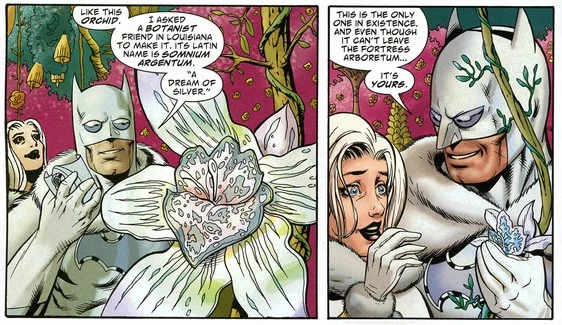
Worst of the Worst: ‘Batman: The Widening Gyre’ #6

Kevin Smith's Batman stories are the worst Batman comics I've ever read, and while I haven't actually read them all, I've read enough that I'm pretty comfortable in declaring them the worst Batman comics ever. And with this week's release of "Batman: The Widening Gyre" #6, Smith has somehow managed to punch through the bottom of the barrel and discover a world of storytelling so thoroughly awful that I can almost -- almost -- admire it for its sheer purity.
This thing is up there with "Rise of Arsenal" #3 for being one of the worst super-hero comics of the year, which, when you consider the competition, puts it squarely in the running for the worst of all time, and on one level, it's actually kinda hard to blame the creators.
Let's face it: Kevin Smith is a comics fan. That's one of the things he built his reputation on through his movies. He was the filmmaker who wore his geek influences on his sleeve, and whether or not it's another symptom of parts of the comics industry being so insecure that they beg for the table scraps of other media, the fact that he's a high profile fan is a key aspect to these books.

He's a fan. And if you're a fan and DC Comics comes to you and says "Hey, write us a comic, you can do whatever you want," of course he's going to do it. That's what every fan dreams of. It even goes a long way to forgiving the not-very-good art by long-time Smith friend Walter Flanagan, because after all: Getting your friend a job drawing Batman? That's just being a good pal.
Unfortunately, a creator -- any creator, in any creative field -- has to recognize his or her limits, and if he can't, that's what an editor's for. And you eventually come to a point where either the editor has to look at something and decide that it's an unpublishable mess or the creator has to take a step back and ask himself if he really wants his contribution to a 70-year legacy be a story where Batman gets high and pisses himself.
"Widening Gyre" is the most compelling argument I've seen for the distinction between fan-fiction and "legitimate" comics writing being purely monetary, because there is no qualitative distinction whatsoever between what Smith's doing here and what JokerScarz666 puts up on his LiveJournal. Smith's writing on Batman is marked by nothing so much as a pervasive immaturity. He writes like a 13-year-old in every possible way.
It's not just in his signature fascination with sex (Smith's previous mini-series, "Cacophony" opens with Mr. Zsasz running out of room on his body and having to carve a tally mark on his penis, and then follows that up with the Joker offering to let someone have anal sex with him in return for breaking him out of prison), and drugs (the first issue of "Widening Gyre" has Batman incapacitated by Poison Ivy synthesizing marijuana and getting him high), but also in the idea that these are Dark, Mature, Adult things. It's coupled with the idea that trivia and minutiae, the things that every kid obsesses over, are a substitute for storytelling and that all will be forgiven if you throw some old Catwoman costumes and draw the Batcave with some stuff from the TV show in the background. And underneath it all is the idea that someone actually thinks this is good, and it's just sad.
It comes to a head in this issue, which just gets worse on every page. To start with, there's the scene where Batman, in his "Watchmen" #11 Nite-Owl cosplay, takes Silver St. Cloud to the Fortress of Solitude to give her a flower:

You may notice that this is a lift from Batman's birthday present to Superman in "Whatever Happened to the Man of Tomorrow," and that Superman namedrops "a BOTANIST friend in Louisiana," an aren't-I-clever reference to Swamp Thing. Smith is so enamored with his own knowledge of super-hero comics -- and his own desire to make sure we all know he's read a lot of super-hero comics -- that his writing slips into the "_____ Movie" style of just reminding you that other things exist.
Aside from the fact that there's no reason to riff on -- sorry, homage one Alan Moore comic when you can get three at the same time, there's no reason for this to take place at the Fortress of Solitude other than hey, it'd be kinda neat to see a picture of the Fortress of Solitude. That, in the world of this book, is a valid storytelling purpose.
This, for the record, is the high point of the issue. After a scene in which Smith and Flanagan remind you that "Star Trek" is a thing that exists, and Batman proposes to Silver St. Cloud (thus starting the inevitable and utterly unsurprising countdown to Silver getting her throat cut at the end of the issue), she explains to Alfred that she refers to Batman as "Deedee" because...

...he gave her eleven orgasms the first time they had sex.
You know, that's great. Really super. Batman is, after all, the best there is at everything. But you know, it's not really a punchline worth six issues -- or, in Kevin Smith time, eleven months -- of setup.
This, for the record, is where it starts to get really stupid. Batman decides to smack Silver around a bit...

...but it's okay, because she understands that he did it because he loves her and thinks she might be a robot:

Oh well. At least he apologizes.
This is all done, I swear to God, so that Batman can learn that not everyone is a robot. He has to learn to trust. And by that, I of course mean that he has to act like an idiot for the rest of the story because that's the only way the plot can come to any semblance of working.
In addition to Batman's relationship with Silver St. Cloud, "Widening Gyre" has largely focused on a new vigilante in Gotham City named "Baphomet," who is so super awesome that he can totally take out the Joker all by his own self in a nice textbook example of bad storytelling. It's so fanfic that the only way it could be any worse is if he didn't turn out to be Onomatopoeia.
Whoops. Spoiler warning, I guess.
I've mentioned before that I actually kind of like Onomatopoeia, although I'm pretty sure it's not for reasons that Smith intended way back when he created him for "Green Arrow." He just feels like a goofy Silver Age villain that got a super-gritty '90s remake and became a serial murderer instead of robbing the Sound Effects museum of whatever, except that there's no Silver Age. He was actually meant to be that way.
Anyway, he ends up cutting Silver's throat because Batman -- who, again, has learned to be an idiot for the purposes of this story -- decides to go ahead and bring Baphomet back to the Batcave and reveal both his secret identity and that of the girl he just asked to marry him.
For the record, this happens about three pages after Baphomet talks about how he totally wants to kill super-villains, which I wouldn't think would endear you to Batman to the point where he'd bring you over to his anti-crime basement and reveal his identity, but then again, I wouldn't think Batman's explanation for not killing the Joker would be "Well, I'd have to kill them all if I did that and it's just such a hassle," either. Go fig.
And again, this is not the dumbest part. For me, that's tied between two things, the first of which is this panel:

Putting aside the fact that Deadshot can tell what kind of crossbow it is by feeling the point of the arrow through his helmet (which... whatever), there's Baphomet talking about his crossbow's firing pin.
Crossbows do not have firing pins. Guns have firing pins. Because guns, unlike crossbows, operate by setting off an explosion that propels the bullet, and that is what the firing pin is for. Crossbows, on the other hand, do not make explosions. They propel bolts by using a bowstring, which I suspected would be the case because I have seen a crossbow before.
Yes, this is nitpicking, but I learned these facts because I typed the word "crossbow" into Wikipedia, and that is literally the bare minimum amount of research a person can do.
I'm pretty sure the bit that's going to be getting the press, though, is this:

Not content to ruin his own comics, Smith flashes back to one of the pivotal moments of "Year One" and decides that you know what? This would be way better with Batman pissing himself.
School in the summertime, folks. No class.
Scott McCloud referred to storytelling in comics as "the invisible art," but while good storytelling does allow you to lose yourself in the story to the point where you don't notice the process, there are plenty of great stories where you can see the amount of craft that goes into it. Research, emotion, study, care in one's work, these are noticeable things that add to a story.
And it's also pretty noticeable when a guy just sits around going "hey wouldn't it be hilarious if Batman talked about peeing in his trunks?" and nobody bothers to tell him no.
More From ComicsAlliance









